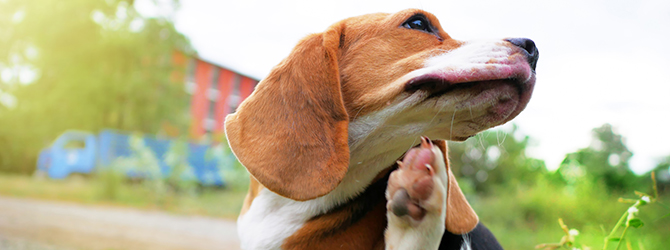Dog hay fever symptoms and treatments: does your dog have hay fever?
First Published: 28/11/2019
Last Updated: 17/10/2023
If you’re a hay fever sufferer, you’ll know full well how frustrating and uncomfortable the pollen season can be.
It’s a trying time for us humans, and can even inhibit our much-loved outdoor adventures.
But did you know that dogs can suffer from hay fever too? Just like humans, certain breeds are more susceptible and symptoms will vary slightly from dog to dog.
Let’s take a closer look at dog hay fever, how it differs from human hay fever, how to spot it and how to keep your dog as comfortable as possible during allergy season.
So, define hay fever
Hay fever refers to the allergy of airborne pollen. Symptoms, with both dogs and humans, are brought about when pollen makes contact with the skin. Hay fever occurs typically when pollen counts are high, which in the UK occurs during May – July.
Dog hay fever: symptoms
The symptoms of dog hay fever can be quite similar to hay fever in humans, but with some distinct differences. They include:
- Regular sneezing
- Itchy or inflamed eyes
- A runny nose
The main way in which dog hay fever differs from human hay fever is that it can have a dramatic effect on your dog’s skin. Your dog could be suffering from hay fever if they itch, bite or rub their paws, armpits, abdomen, legs, groin or face. You may be able to see patches where their skin is dry, flaky or inflamed.
Dog hay fever vs. other conditions
As canine allergies go, hay fever is relatively rare in dogs. If your dog is itchy, the cause is more likely to be fleas or dust mites than hay fever, so it’s important to contact your vet if you’re concerned; they’ll be able to conduct an allergy test and check the exact cause of your dog’s irritation.
Dry eye in dogs can also be commonly mistaken for hay fever, but these conditions are quite different. Find out more about dry eye in dogs.

How to treat my dog’s hay fever?
Sadly, there is no complete and utter dog hay fever treatment that will completely rid your dog of their pollen allergy. Hay fever cannot be ‘cured’ per say, although there are plenty of great methods to ease your dog’s symptoms:
- Ear drops
- Eye drops
- Cleansing wipes
- Medicated shampoos, creams and related products
Medication such as antihistamines can make for effective dog hay fever treatments, although they tend not to be as effective as they are for humans. It’s important to note that certain forms of antihistamines can be poisonous to dogs, so you should only use products that have been prescribed by your vet.
Home remedies
Another effective method of handling your dog’s hay fever is to limit their exposure to pollen. You can do this by making changes both to your routine and to your dog’s home environment during those months of the year where the pollen count is high.
Try to walk your dog early in the morning and later on at night, that way you’ll avoid the midday pollen extravaganza. Be sure to wash your dog thoroughly when you get home, this will help to remove excess pollen from their body.
Regular vacuuming and lawn mowing, along with washing your dog’s bedding on a weekly basis and keeping them up to date with their flea & worm treatment will also help to reduce your dog’s exposure to pollen and prevent itchiness.
Need more info?
For more information on dog hay fever symptoms and treatment, canine allergies or any other aspect of your dog’s health and wellbeing, have a chat with your vet.
Find your nearest vet using our Find a Vet page, or speak to a vet online using Online Vets.


